Training Resources
1. Introduction
According to Juniper Analytics, there will be a three-fold rise in Conversational bots by 2023. The demand is high since these bots provide a communication experience that mimics the behaviour of a human agent. These bots work on advanced NLP and are trained on FAQs to provide relevant information for a user query,
Advanced NLP enables users to add entities to FAQs to improve the search capability and also remove redundancy from the bot. Floatchat’s NLP Engine e-sense processes the query asked by the user and covers spelling and grammatical mistakes that a user may make while asking a question to the bot.
The system then sends a match percentage with an answer already defined and based on that provides an answer.
Training a bot means in cases where a wrong answer is triggered or a default response is triggered can be remapped to the correct answer which will return the desired output in the next attempt. For Instance, if a user asks a ticket booking bot about available shows and the bot does not provide a valid answer the bot can be then trained with a new response or tag it to an existing relevant response to provide the required if the same query is triggered again.
According to Juniper Analytics, there will be a three-fold rise in Conversational bots by 2023. The demand is high since these bots provide a communication experience that mimics the behaviour of a human agent. These bots work on advanced NLP and are trained on FAQs to provide relevant information for a user query,
Advanced NLP enables users to add entities to FAQs to improve the search capability and also remove redundancy from the bot. Engati’s NLP Engine e-sense processes the query asked by the user and covers spelling and grammatical mistakes that a user may make while asking a question to the bot.
The system then sends a match percentage with an answer already defined and based on that provides an answer.
Training a bot means in cases where a wrong answer is triggered or a default response is triggered can be remapped to the correct answer which will return the desired output in the next attempt. For Instance, if a user asks a ticket booking bot about available shows and the bot does not provide a valid answer the bot can be then trained with a new response or tag it to an existing relevant response to provide the required if the same query is triggered again
2. Accessibility
A user can train a selected bot by clicking on the train button on the left panel and then selecting Responses.
For the response that the user wants to train the bot, he/she needs to click on the options present on the right-hand side of every response and then select the Train option.
This functionality is provided to all users.
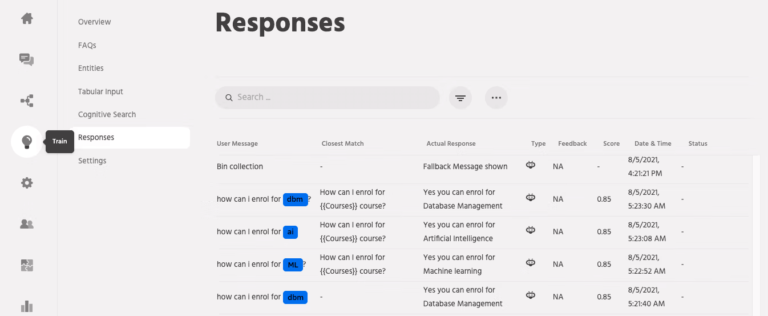
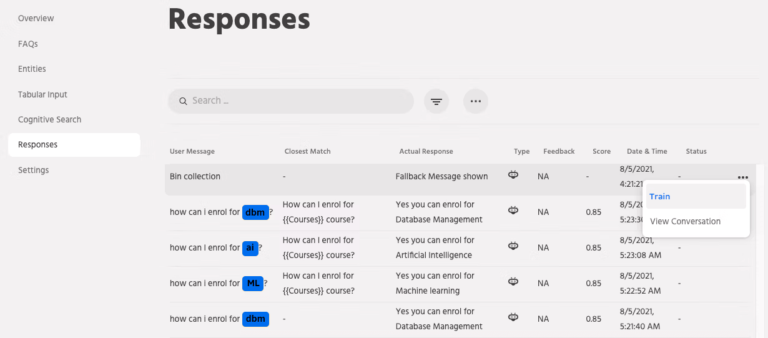
A user can train a selected bot by clicking on the train button on the left panel and then selecting Responses.
For the response that the user wants to train the bot, he/she needs to click on the options present on the right-hand side of every response and then select the Train option.
This functionality is provided to all users.
3. Terms and Definitions
Terms | Definitions |
NLP | Natural Language Processing is the ability of a computer program to understand human language as it is spoken. NLP is a component of artificial intelligence (AI) |
Entities | It is a data point or value which you can extract from a conversation/user query. This helps you to customize what kind of information you are collecting or how you want to associate it or want to add some custom value to it. For more information on entities and intents. |
FAQ | Frequently Asked Questions (FAQs) are the standard queries relevant to a product or a service. For more information on FAQs. |
Terms
Definitions
NLP
Natural Language Processing is the ability of a computer program to understand human language as it is spoken. NLP is a component of artificial intelligence (AI)
Entities
It is a data point or value which you can extract from a conversation/user query. This helps you to customize what kind of information you are collecting or how you want to associate it or want to add some custom value to it. For more information on entities and intents .
FAQ
Frequently Asked Questions (FAQs) are the standard queries relevant to a product or a service. For more Information on FAQs .
4. Training Process
- A user types in a query/question on your bot
- Your bot gets the closest matching query saved by you in your FAQ module
- Bot triggers an answer mapped to that query
- You can monitor the responses under the Responses section of the Train tab
For an unsatisfactory/no response situation, click Train from the right side menu option, to provide the right/improve the answer for the given query.
4.1 Steps to train a bot for an FAQ
Step 1: Click on the Train tab on the left panel on your Floatchat app page and click on Responses.

This tab will list all the queries with date and time information that are asked on the bot. You can see the query asked by the user, the closest matching query listed by the system and the response provided for the same.
Step 2: From the option on the right side of the FAQ response you want to train your bot for, click Train.

Step 3: The modal that opens will show you the question and the closest matching answer.

What can be done here to Improve responses?
Solution 1: Add a new response to the question
- Click on new
- Select a response type as Message or path
- Add new answer
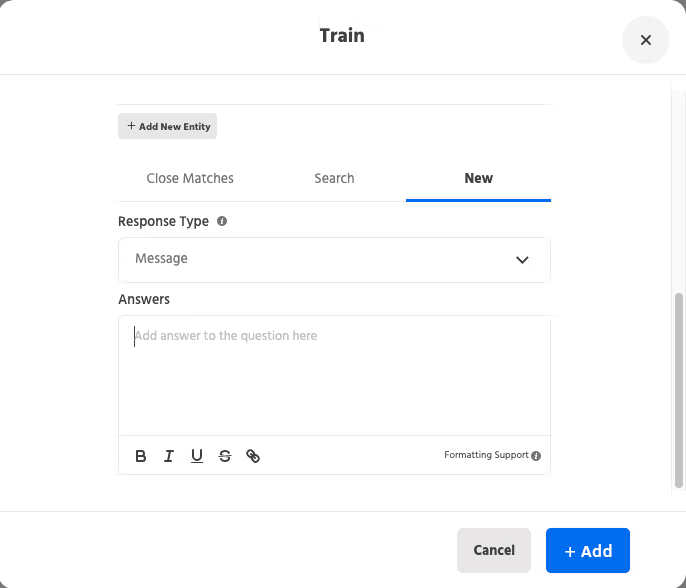
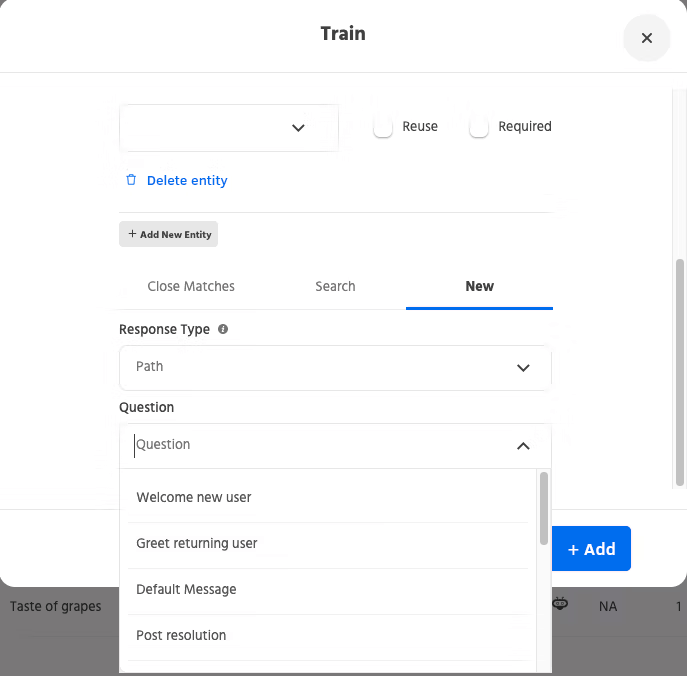
Solution 2: Add more variations to the question so that points to the right answer
- Click on the (+ Add Question) sign below the questions tab and add more variations to the same question.
Variations are added to nullify inconsistencies in queries. A user may ask the same question in a different manner than the other.
– Example:
- U1: How can I book my ticket using your bot?
- U2: Can I make a reservation on your bots?
- U3: Can we reserve our seats on the bot?
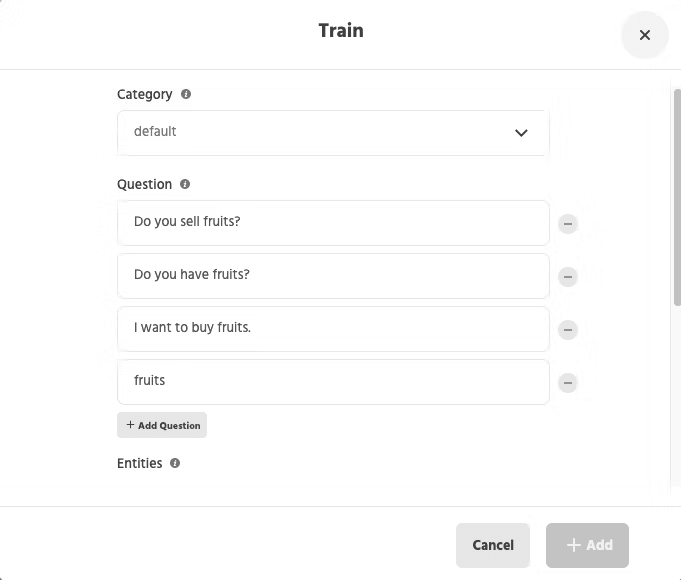
Solution 3: Add Entities
Entities are data points or values which you can extract from a conversation/user query. This workflow allows you to customize what kind of information you are collecting, how you want to associate it and add your own custom set of values if needed.
Example: Let’s consider a use case where you want to trigger a standard response for a set of values. In this case Course enrolment process. We can create a custom entity named course which can trigger a standard response for all course-related queries.
4.2 Adding an entity
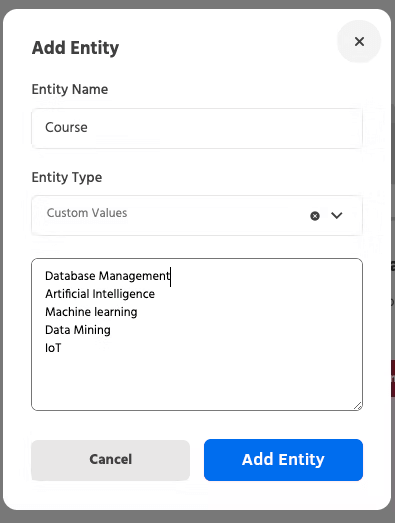
4.3 Tagging an entity in a FAQ

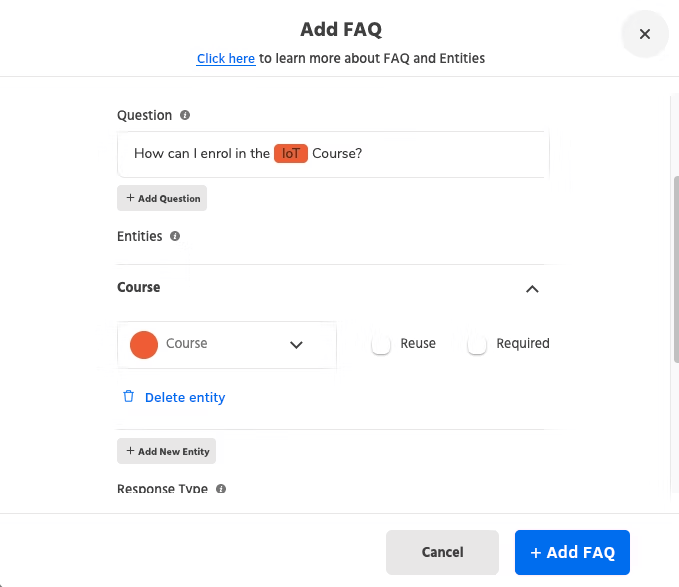
4.4 Query and its response

4.5 To understand the context of the conversation while training
Context of the overall conversation can also play a vital role while training a bot for a particular query. If a bot builder/owner wants to be redirected to the point in the conversation where this query was encountered by the bot, he/she can do that by clicking the button on the right side of the query and clicking on View Conversation.

Illustration: Train a bot to handle the variation of queries mentioned above
4.6 Pre-training Mode
FAQ added in the bot: How can I book my ticket using your bot?

Test Query 1: How can I book my ticket using your bot?
Test Query 2: Can I make a reservation on your bots?
Test Query 3: Can we reserve our seats on the bot?
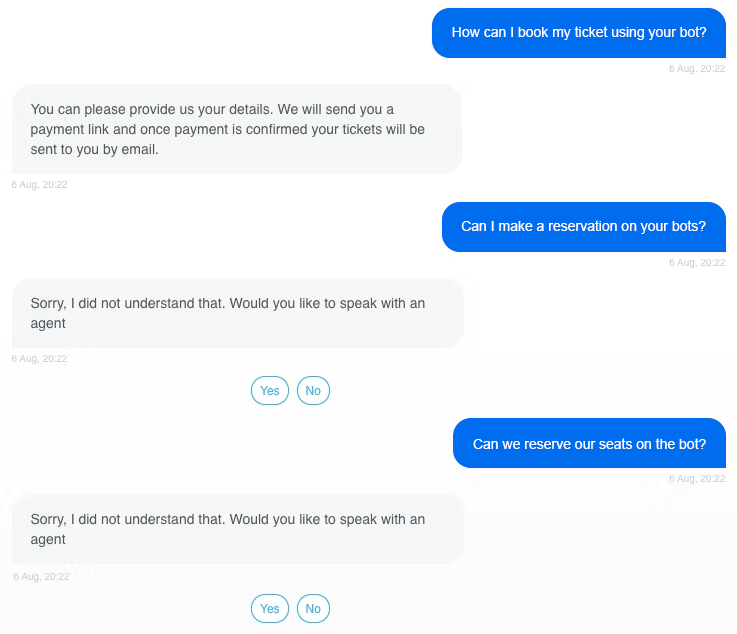
4.7 Training the bot
Click on Train on the left Panel and select Responses.
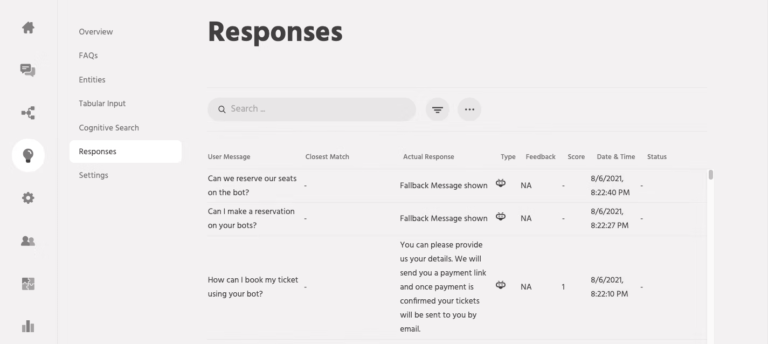
Click on the right-hand side button, of the query that we need to add variations for which we did not receive an answer.

We can select the closest matching response if it is right or add a new response if no valid response exists. In this case, we can see that there is the closest matching response. Select it and save it.
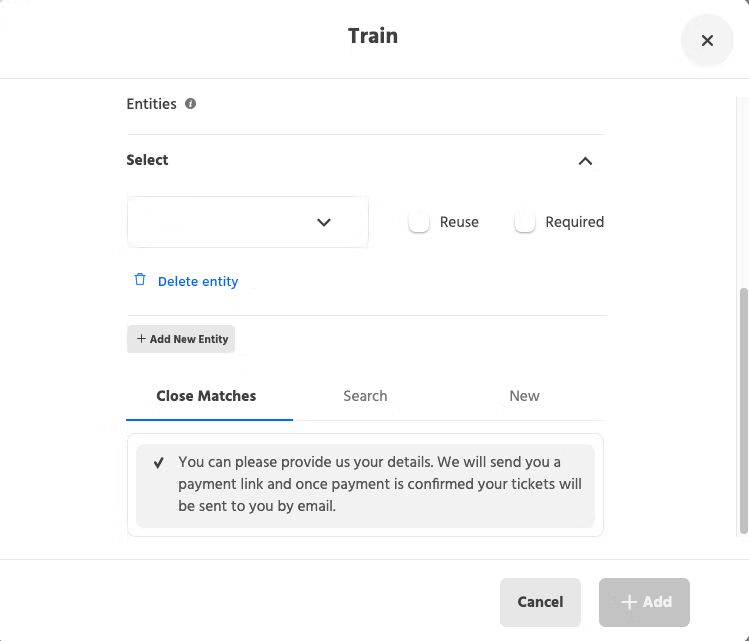
4.8 Similarly training for other unanswered responses.

Test Post-training
Test Query 1: How can I book my ticket using your bot?
Test Query 2: Can I make a reservation on your bots?
Test Query 3: Can we reserve our seats on the bot?
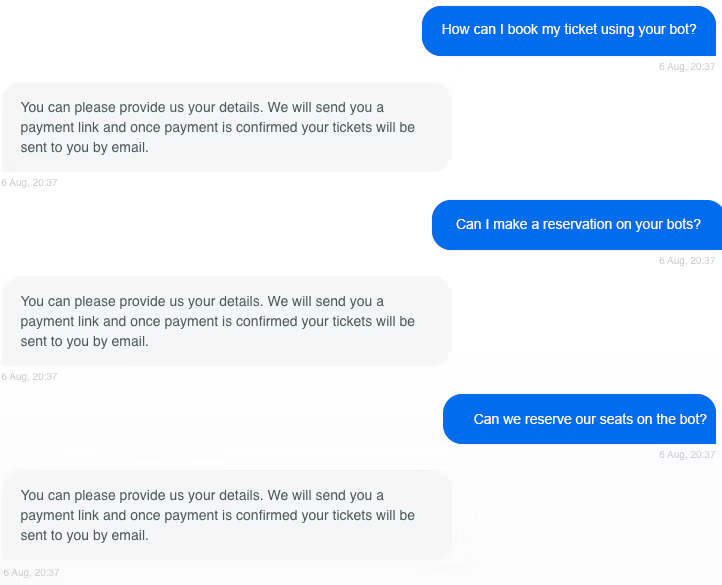
We can see that the bot returns the trained response now.
- A user types in a query/question on your bot
- Your bot gets the closest matching query saved by you in your FAQ module
- Bot triggers an answer mapped to that query
- You can monitor the responses under the Responses section of the Train tab
For an unsatisfactory/no response situation, click Train from the right side menu option, to provide the right/improve the answer for the given query.
4.1 Steps to train a bot for an FAQ
Step 1: Click on the Train tab on the left panel on your Engati app page and click on Responseshis tab will list all the queries with date and time information that are asked on the bot. You can see the query asked by the user, the closest matching query listed by the system and the response provided for the same. Step 2: From the option on the right side of the FAQ response you want to train your bot for, click Train.Step 3: The modal that opens will show you the question and the closest matching answer.
What can be done here to Improve responses?
Solution 1: Add a new response to the question
- Click on new
- Select a response type as Message or path
- Click on the (+ Add Question) sign below the questions tab and add more variations to the same question.
Solution 2: Add more variations to the question so that points to the right answer
- Click on the (+ Add Question) sign below the questions tab and add more variations to the same question.
Solution 3: Add Entities
Entities are data points or values which you can extract from a conversation/user query. This workflow allows you to customize what kind of information you are collecting, how you want to associate it and add your own custom set of values if needed.
Example: Let’s consider a use case where you want to trigger a standard response for a set of values. In this case Course enrolment process. We can create a custom entity named course which can trigger a standard response for all course-related queries.
4.2 Adding an entity Tagging an entity in a FA
4.3 Query and its response
4.4 To understand the context of the conversation while training- Context of the overall conversation can also play a vital role while training a bot for a particular query. If a bot builder/owner wants to be redirected to the point in the conversation where this query was encountered by the bot, he/she can do that by clicking the button on the right side of the queryAdd new answer
Solution 2: Add more variations to the question so that points to the right answer
4.6 Pre-training Mo
- Test Query1: How can I book my ticket using your bot?
Test Query2: Can I make a reservation on your bots?
Test Query3: Can we reserve our seats on the bot?4.7 Training the botClick on the right-hand side button, of the query that we need to add variations for which we did not receive an answer.We can select the closest matching response if it is right or add a new response if no valid response exists. In this case, we can see that there is the closest matching response. Select it and save it.4.8 Similarly training for other unanswered responses.4.8 Similarly training for other unanswered responses.
